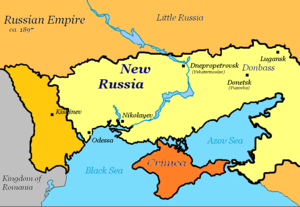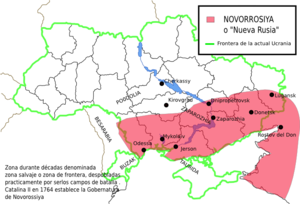- Novorossiya
-
 A map of what was called New Russia during the time of the Russian Empire. The parts of Novorossiya that are now in Russia are not shown.
A map of what was called New Russia during the time of the Russian Empire. The parts of Novorossiya that are now in Russia are not shown.
History of Russia 
This article is part of a seriesVolga Bulgaria (7th–13th) Khazar Khaganate (7th–10th) Rus' Khaganate (8th–9th) Kievan Rus' (9th–12th) Vladimir-Suzdal (12th–14th) Novgorod Republic (12th–15th) Mongol invasion (1220s–1240s) Tatar Yoke (13th–15th) Grand Duchy of Moscow (1340–1547) Tsardom of Russia (1547–1721) Russian Empire (1721–1917) Russian Provisional Government / Russian Republic (1917) Russian SFSR / Soviet Union (1917–1991) Russian Federation (1992–present)
Russia Portal
History of Ukraine 
This article is part of a series- Cassette Scandal
- Orange Revolution
- Russia–Ukraine gas disputes
Novorossiya (Russian: Новоро́ссия, Ukrainian: Новоросія; literally New Russia) is a historic area of lands which established itself solidly after the annexation of the Crimean Khanate by the Russian Empire, but was introduced with the establishment of Novorossiysk Governorate with the capital in Kremenchuk in the mid 18th century. Until that time in both Polish and Russian, the area was well known as the Wild Fields. It roughly covers modern territories of southern Ukraine, southern Russia, Bessarabia.
The western part of it (between the Dniester and the Dnieper rivers) was known as Dykra in the Grand Duchy of Lithuania and subsequently the province of Yedisan, an autonomous region of the Ottoman Empire, and was previously inhabited mostly by ethnic Tatars Nogais who moved in the area during the Golden Horde conquest.
The Russian Empire gradually gained control over the area by peace treaties with Cossack Hetmanate and the Ottoman Empire at the conclusion of the Russo-Turkish Wars of 1735–39, 1768–74, 1787–92 and 1806–12. It also forcefully liquidated the Free lands of Zaporizhian Sich as they became inconvenient for Russian colonization. The colonization of the land at the end of 18th century was led by Prince Grigori Potemkin who was granted the powers of an absolute ruler over the area by Catherine the Great. The lands were generously given to the Russian dvoryanstvo (nobility), and the enserfed peasantry mostly from Ukraine and fewer from Russia were transferred to cultivate what was a sparsely populated steppe. Catherine the Great also invited European settlers to these newly conquered lands: Germans, Poles, Italians, Greeks, Serbs, and others. Over time the people living in eastern regions have developed a more pro-Russian orientation. In the former New Russia, the Russian language is common in cities and some areas outside, while Ukrainian is more prevalent generally in rural areas, smaller towns, and villages. With its history, the ethnic composition varies, including communities of Greeks, Bulgarians, Armenians, Tatars, and many others.
New cities founded during colonization included Novorossiysk, Yekaterinoslav (now Dnipropetrovsk), Nikolaev, Kherson, and Odessa. Also the cities such as Mariupol and Staryi Krym (Donetsk oblast) that were founded on national basis reflect the ethnic composition in the region.
In modern terms it encompasses Donetsk Oblast, Luhansk Oblast, Dnipropetrovsk Oblast, Zaporizhia Oblast, Mykolaiv Oblast, Kherson Oblast, Odessa Oblast and Crimea in Ukraine, Krasnodar Krai, Stavropol Krai, Rostov Oblast, and the Republic of Adygea in Russia.
In the 2006 Ukrainian parliamentary election, the Party of Regions, which often speaks out on behalf of protecting Russian language, gained a majority in the regions of southern Ukraine where the region of Novorossiya used to exist.
See also
References
External links
Categories:- Subdivisions of the Russian Empire
- Traditional subdivisions of Russia
- History of Russia
- History of Moldova
- History of Ukraine
- Historical regions in Ukraine
- Russians in Ukraine
- Russian history stubs
- Ukrainian history stubs
- Moldova stubs
Wikimedia Foundation. 2010.

